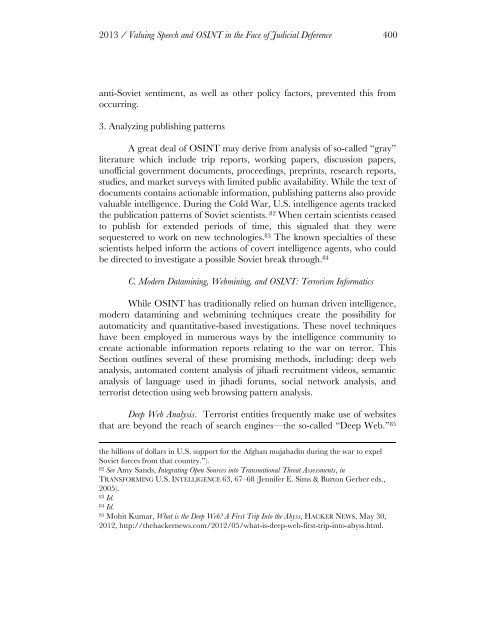Vo.4-Moshirnia-Final
Vo.4-Moshirnia-Final
Vo.4-Moshirnia-Final
Create successful ePaper yourself
Turn your PDF publications into a flip-book with our unique Google optimized e-Paper software.
2013 / Valuing Speech and OSINT in the Face of Judicial Deference 400<br />
anti-Soviet sentiment, as well as other policy factors, prevented this from<br />
occurring.<br />
3. Analyzing publishing patterns<br />
A great deal of OSINT may derive from analysis of so-called “gray”<br />
literature which include trip reports, working papers, discussion papers,<br />
unofficial government documents, proceedings, preprints, research reports,<br />
studies, and market surveys with limited public availability. While the text of<br />
documents contains actionable information, publishing patterns also provide<br />
valuable intelligence. During the Cold War, U.S. intelligence agents tracked<br />
the publication patterns of Soviet scientists. 82 When certain scientists ceased<br />
to publish for extended periods of time, this signaled that they were<br />
sequestered to work on new technologies. 83 The known specialties of these<br />
scientists helped inform the actions of covert intelligence agents, who could<br />
be directed to investigate a possible Soviet break through. 84<br />
C. Modern Datamining, Webmining, and OSINT: Terrorism Informatics<br />
While OSINT has traditionally relied on human driven intelligence,<br />
modern datamining and webmining techniques create the possibility for<br />
automaticity and quantitative-based investigations. These novel techniques<br />
have been employed in numerous ways by the intelligence community to<br />
create actionable information reports relating to the war on terror. This<br />
Section outlines several of these promising methods, including: deep web<br />
analysis, automated content analysis of jihadi recruitment videos, semantic<br />
analysis of language used in jihadi forums, social network analysis, and<br />
terrorist detection using web browsing pattern analysis.<br />
Deep Web Analysis. Terrorist entities frequently make use of websites<br />
that are beyond the reach of search engines—the so-called “Deep Web.” 85<br />
the billions of dollars in U.S. support for the Afghan mujahadin during the war to expel<br />
Soviet forces from that country.”).<br />
82 See Amy Sands, Integrating Open Sources into Transnational Threat Assessments, in<br />
TRANSFORMING U.S. INTELLIGENCE 63, 67–68 (Jennifer E. Sims & Burton Gerber eds.,<br />
2005).<br />
83 Id.<br />
84 Id.<br />
85 Mohit Kumar, What is the Deep Web? A First Trip Into the Abyss, HACKER NEWS, May 30,<br />
2012, http://thehackernews.com/2012/05/what-is-deep-web-first-trip-into-abyss.html.
















